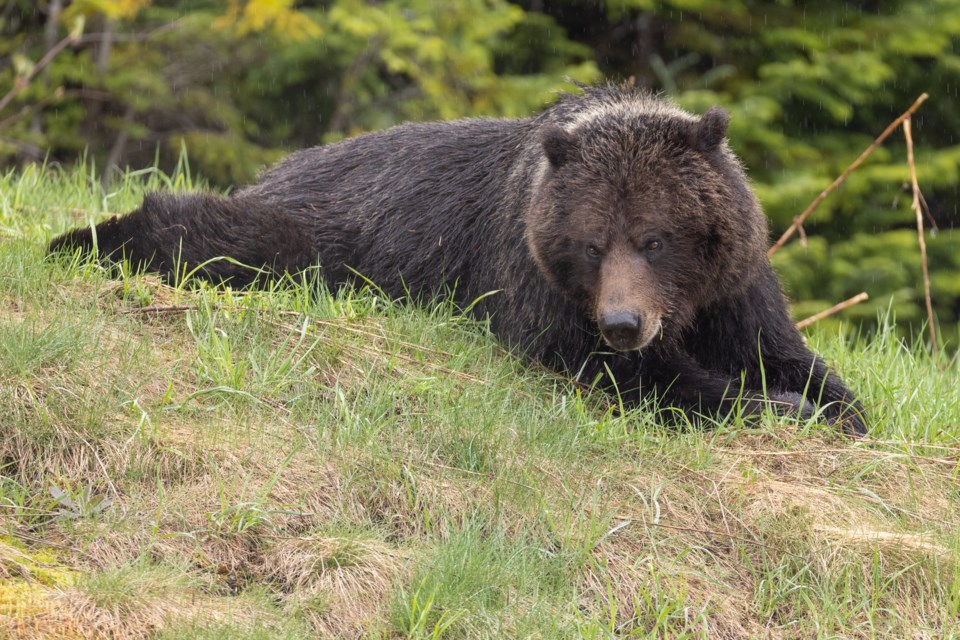As I encountered the first grizzly poops of fall around the outskirts of town a few weeks back, I was naturally given to reminisce about the opportunity to see them hanging out on the Fairmont golf course, at Myrtle Philip fields last fall, and in Cheakamus last spring.
Beyond being wonderful windows into a little-appreciated part of local nature, these advents also provided insights both comical and sad into people’s reactions and malign behaviour when it comes to nature: confusion with brown-coloured black bears, erroneous posts to this end, endless letters to the editor and people just generally getting bent out of shape because an animal endemic to this region was actually in their midst—but not bent out of shape enough to responsibly leash their dogs or leave it alone, as tourist drive-bys showed. So far, the increasing South Coast grizzly population represented by the odd Whistler visitor is generally skirting trouble—despite the pressing humanity they often have to contend with. But I wonder how soon until we tragically lose one of these majestic creatures.
Because it happens far too often.
South of the border last week, in the dark of night, only weeks from going into hibernation for her 28th time, Grizzly 399 was killed by a vehicle in Wyoming’s Snake River Canyon. Known variously as the matriarch of the Northern Rockies and Queen of the Tetons, the impressively aged (for a grizzly) sow had mothered 18 cubs and was travelling with her latest yearling at the time (thankfully unharmed and likely to survive the winter). Her loss was devastating to those who had come to know her over the years: tourists, wildlife managers, park rangers, biologists, filmmakers and photographers—one of whom, after discovering Grizzly 399 and her three cubs 18 years ago, photographed and filmed her some 100 to 150 days each year since.
The hole in people’s hearts was as big as the hole in the ecological landscape of Grand Teton National Park, and it immediately reminded me of an even more wrenching scenario that unfolded in our own country, when another iconic grizzly, one I’d actually researched and written about, was likewise lost to the carelessness of humanity.
When Banff National Park’s iconic Bear 148 was shot and killed by a trophy hunter near McBride, B.C., on Sept. 24, 2017, it wasn’t only the death of the beloved six-year-old female—or even the symbol of human-bear conflict she had become—that was grieved. Similarly, it wasn’t the fact the then-newly minted NDP government’s ban on trophy hunting didn’t come into effect until the following month that provided the most irony. Instead, a greater tragedy lay in the final blow to our many attempts to understand Bear 148, to get out of her way and to save her from just such a fate. In her lonely demise—wandering confused through an unknown environment some 500 kilometres northwest of her home—was also writ a final passing of the silly human hubris that imagined we could do so.
In the end, all of our efforts were moot: with a probability so high it wasn’t worth contemplating, the life of Bear 148 was prescribed to be cut prematurely short from the moment she was born.
Young bears don’t choose their home range, and when these are peopled areas with high anthropogenic impact like Banff, the writing is on the wall. Bear 148 learned well from her mother, the equally iconic Bear 64, how to navigate this world. Surrounded by thousands of humans annually, Bear 148 did a good job of avoiding them—and letting them know how much space she needed. Many hundreds had positive encounters with her, embracing her importance to the park and its landscape. But the nature of that relationship kept changing, the goalposts of our expectations moved by development and ever-increasing numbers of people.
For a bear known through satellite tracking data to almost always move within 100 metres of public areas, unencumbered use of the so-called wildlife corridors available to her became almost impossible. Add in a shift in behaviour probably linked to pregnancy and the dominoes began to fall. In early summer of 2017, after several unusually close encounters with people, Bear 148 left Banff’s protective borders for another part of her range in nearby Canmore. Here, unfortunately, encounters ramped up, culminating in an incident involving the bane of wildlife managers—unleashed dogs. Relocated by Alberta Fish and Wildlife officials to adjacent Kootenay National Park, Bear 148 naturally beelined back to Canmore in under 10 days, where problems continued and government agencies considered more drastic measures.
By July, some 27,300 people had signed a Change.org petition demanding Bear 148 not be killed and allowed to stay. Though the petition proved integral to keeping her alive, she was nevertheless translocated to Kakwa Wildland Provincial Park in northern Alberta where, wandering over the border into B.C., she became a poster child for what many still see as a desperate need to change local wildlife policies.
In a feature I wrote in Canadian Geographic’s April 2015 issue, “The Way of Bear 148,” I ended the introduction with the following: “With bears as adept as humans at identifying and exploiting opportunities and benefits in our shared environment, where is the line between codependence and conservation?”
The article didn’t seek to answer, but to put the question on the table for public consideration, much as it has been for professional wildlife managers. In the passing of both Bear 148 and Grizzly 399, however, lies a partial, telling answer: when no human approach or effort can prevent us from ultimately killing an animal with which we supposedly coexist, perhaps there is no line at all.
Leslie Anthony is a biologist, writer and author of several popular books on environmental science




